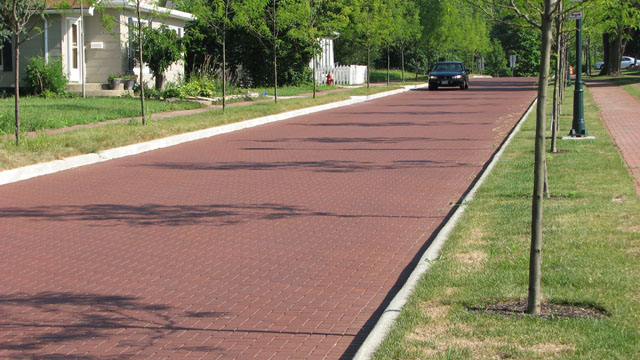November 16, 2011 1:30 PM CST
Made of Pine Hall Brick’s StormPave permeable clay pavers, the new Third Street enables storm water to infiltrate and recharge the water table, instead of washing pollutants across the surface into nearby storm drains or waterways. It’s made of clay brick pavers that naturally are green, since they’re made of clay and water, the most abundant building materials on the planet. Brick pavers also are green because they last for centuries, and are an example of naturally sustainable construction.
But moreover, planners found that it cost virtually the same to put in a permeable paver street as it would have for a conventional asphalt street.
The story began when city officials determined that Third Street needed to be totally reconstructed. The city decided to find out if a material was available that would be more sustainable and environmentally friendly than asphalt.
To put in a conventional street would require new asphalt, conventional curb inlets and underground storm sewer piping, as well as patching and other maintenance in the years to come.
Permeable paver systems require that layers of graded aggregates be hauled to the site and layered for the base, large to small, before the pavers are installed. Once in, the smallest aggregate is swept in the joints. The only required maintenance is that the pavers be vacuumed occasionally to remove debris that would otherwise clog the system.
The bottom line? The costs of putting in permeable pavers came in at $424,389. The estimates for putting in asphalt including five years of maintenance was at $427,718; maintaining it for 10 years raised it to $434,085.
Using permeable pavers goes beyond cost. Brick streets have an aesthetic appeal to many potential residents, and their use often negates the need for additional stormwater retention.
Businesses planning new developments near the Village Center will, therefore, have fewer stormwater issues to engineer as a result of New Albany’s stormwater mitigation strategy, of which Third Street is a part, town officials said in a prepared statement.
Another advantage? “These new pavers will drain better, producing less ice on the surface,” says Public Service Director Mark Nemec. “Plus, brick streets typically calm traffic, so we expect a safer environment for motorists and pedestrians alike.”
Permeable pavers in action
Using permeable pavers goes beyond cost
By Masonry

Brick pavers also are green because they last for centuries.
Visitors to New Albany, Ohio, find themselves in a classic small town: miles of white horse fencing and beautiful brick homes lead to a downtown city center. There, a new brick road is carrying more than traffic.Made of Pine Hall Brick’s StormPave permeable clay pavers, the new Third Street enables storm water to infiltrate and recharge the water table, instead of washing pollutants across the surface into nearby storm drains or waterways. It’s made of clay brick pavers that naturally are green, since they’re made of clay and water, the most abundant building materials on the planet. Brick pavers also are green because they last for centuries, and are an example of naturally sustainable construction.
But moreover, planners found that it cost virtually the same to put in a permeable paver street as it would have for a conventional asphalt street.
The story began when city officials determined that Third Street needed to be totally reconstructed. The city decided to find out if a material was available that would be more sustainable and environmentally friendly than asphalt.
To put in a conventional street would require new asphalt, conventional curb inlets and underground storm sewer piping, as well as patching and other maintenance in the years to come.
Permeable paver systems require that layers of graded aggregates be hauled to the site and layered for the base, large to small, before the pavers are installed. Once in, the smallest aggregate is swept in the joints. The only required maintenance is that the pavers be vacuumed occasionally to remove debris that would otherwise clog the system.
The bottom line? The costs of putting in permeable pavers came in at $424,389. The estimates for putting in asphalt including five years of maintenance was at $427,718; maintaining it for 10 years raised it to $434,085.
Using permeable pavers goes beyond cost. Brick streets have an aesthetic appeal to many potential residents, and their use often negates the need for additional stormwater retention.
Businesses planning new developments near the Village Center will, therefore, have fewer stormwater issues to engineer as a result of New Albany’s stormwater mitigation strategy, of which Third Street is a part, town officials said in a prepared statement.
Another advantage? “These new pavers will drain better, producing less ice on the surface,” says Public Service Director Mark Nemec. “Plus, brick streets typically calm traffic, so we expect a safer environment for motorists and pedestrians alike.”
Originally published in Masonry magazine.
About the Author
Masonry, the official publication of the Mason Contractors Association of America, covers every aspect of the mason contractor profession - equipment and techniques, building codes and standards, business planning, promoting your business, legal issues and more. Read or subscribe to Masonry magazine at www.masonrymagazine.com.


















